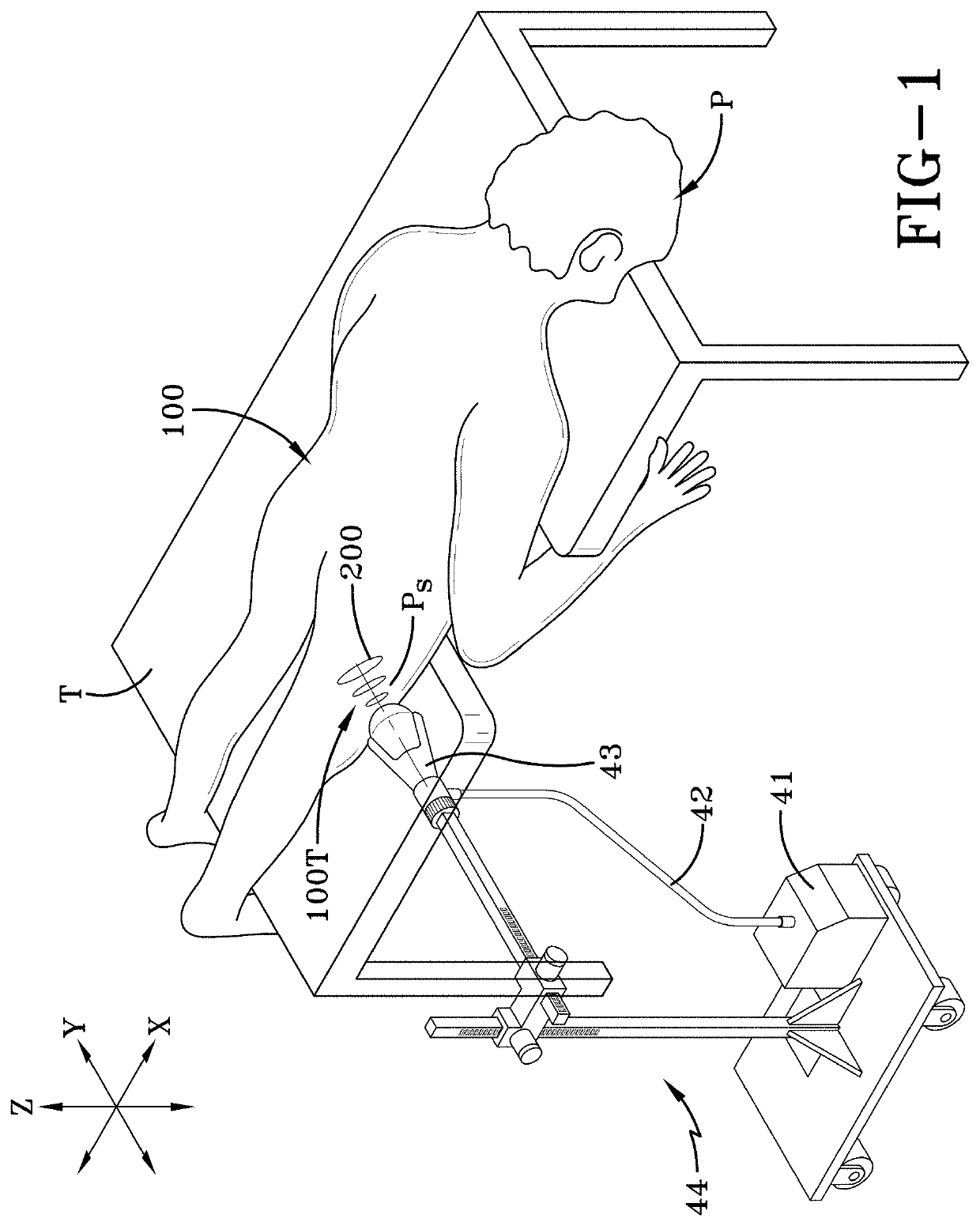[0015]A primary factor in the reluctance to use ESWT was that the believed
threshold energy requirements were so high that the surrounding extremity would hemorrhage, exhibited by hematomas and bleeding around the treated site. This phenomenon is particularly known in the area of focused emitted waves designed for
deep penetration into the patient. US patent publication 2005 / 0010140 recites the disadvantageous effects of
cavitation phenomena can be controlled wherein the
shock wave source is connected to a control means which controls the release frequency of shock waves as a function of
pulse energy in such a manner that higher
pulse energy correlates with lower release frequencies of the shock waves and vice versa. The avoidance of
cavitation occurrences would it is postulated result in far less pain for the patient.
[0016]In US 2006 / 0246044 published on Nov. 2, 2006, Andreas Lutz of Dornier Med Tech Systems in Germany disclosed “Methods for Improving
Cell Therapy and Extremity Regeneration in Patients With Cardiovascular
Disease by Means of Shockwaves”. In this application the use of shock waves is used.
[0017]The present invention recognizes the underlying beneficial attributes of ESWT are not now and may never be fully comprehended, however, under a more advanced molecular theory the authors of the present invention postulated a microbiological model suggesting the response mechanism to such treatment.
[0018]This model attempts to explain the effect of ESWT by postulating
neovascularization of the treated extremity with simultaneous release of diverse growth factors. The enhanced
metabolic activity taking place in the presence of these growth factors could be responsible for the healing of the chronically inflamed extremity while the decrease in
afferent nerve fibers causes the
analgesic effect.
[0019]The present inventor sees that ESWT is a highly versatile therapeutic instrument. It can be used as a bioengineering tool to achieve effects such as the production of growth factors or as a
surgical instrument to effect an extremely subtle type of
denervation. In the field of
traumatology, these properties are used primarily to treat fractures with non-union or delayed osseous union. ESWT is also becoming increasingly important for treating the early stages of osteochondritis dissecans. Heretofore the use of ESWT has never been used as a therapeutic instrument in the treatment of diabetes until the attempt to directly treat a
pancreas of a diabetic to control
insulin production to prevent over production caused by the
pancreas as was described in U.S. Pat. No. 7,988,648 granted Aug. 2, 2011. In this prior art patent, the inventors taught treatment methods for stimulating the tissue of a subsurface organ that was part of the
incretin system. New data unexpectedly has been discovered suggesting a new
preventative treatment for diabetic that is a remote method of controlling
blood sugar levels. US patent publication 2017 / 0296427 published Oct. 19, 2017 entitled “Treatments For
Blood Sugar Levels And
Muscle Tissue Optimization Using
Extracorporeal Acoustic Shock Waves”, disclosed a method of treating red blood cells of a
human patient has the steps of activating an
acoustic shock wave generator or source to emit
acoustic shock waves and subjecting a vascular
system containing red blood cells and surrounding
muscle tissue peripherally through an extremity of a patient to the acoustic shock waves by stimulating the extremity wherein the extremity is positioned within a path of the emitted shock waves and away from a geometric
focal volume or point of the emitted shock waves. This co-pending method which is being incorporated herein in its entirety by reference disclosed a novel way to lower
elevated blood glucose levels in diabetic patients.
[0020]The present invention refines this technique to combine acoustic
shock wave therapy with light therapy to treat even severe cases of
peripheral neuropathy as described more fully as follows with first detailed description of
shock wave therapeutic methods and then a detailed description of several shock wave devices and apparatus for carrying out the methods.SUMMARY OF THE INVENTION
 Login to View More
Login to View More  Login to View More
Login to View More 


